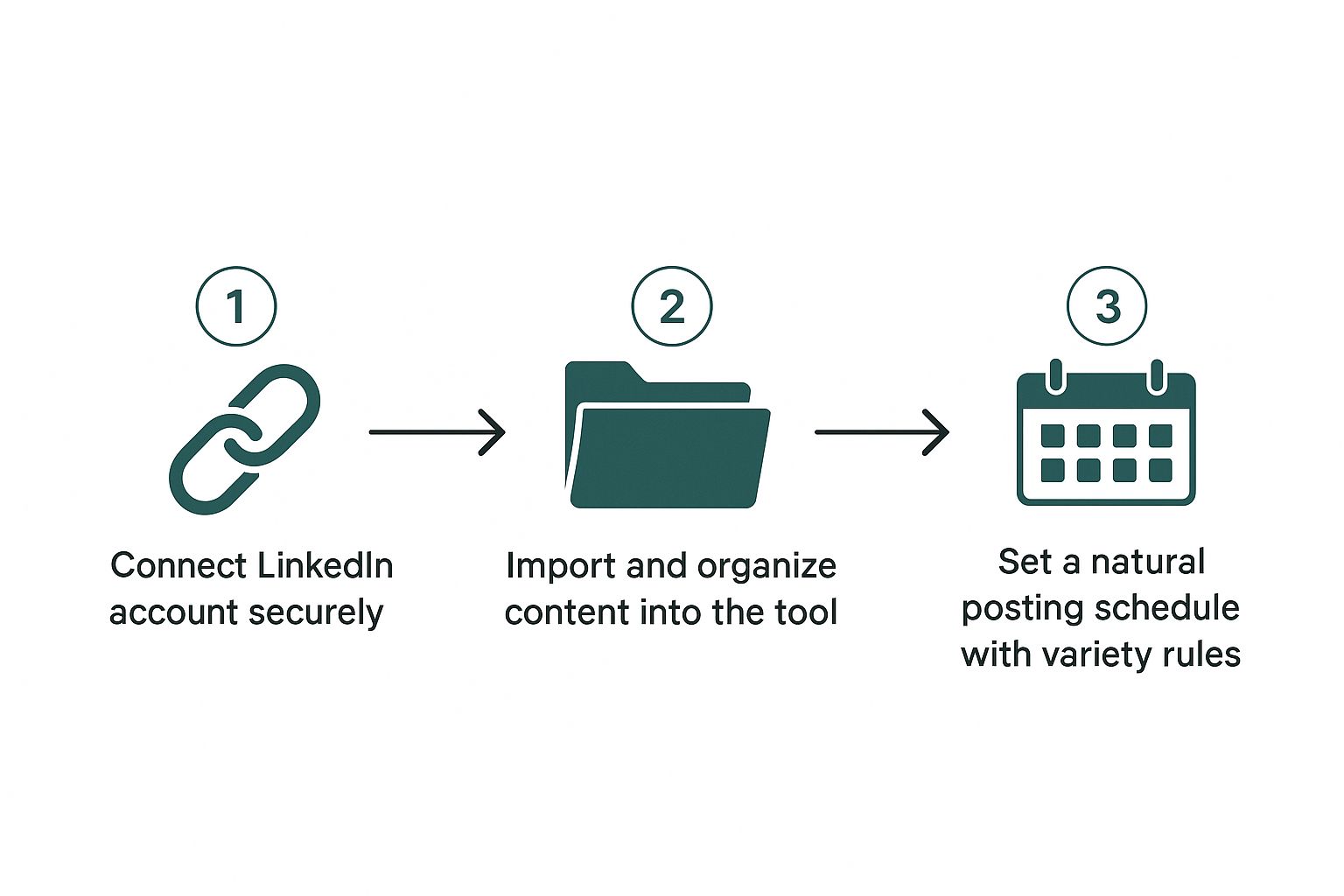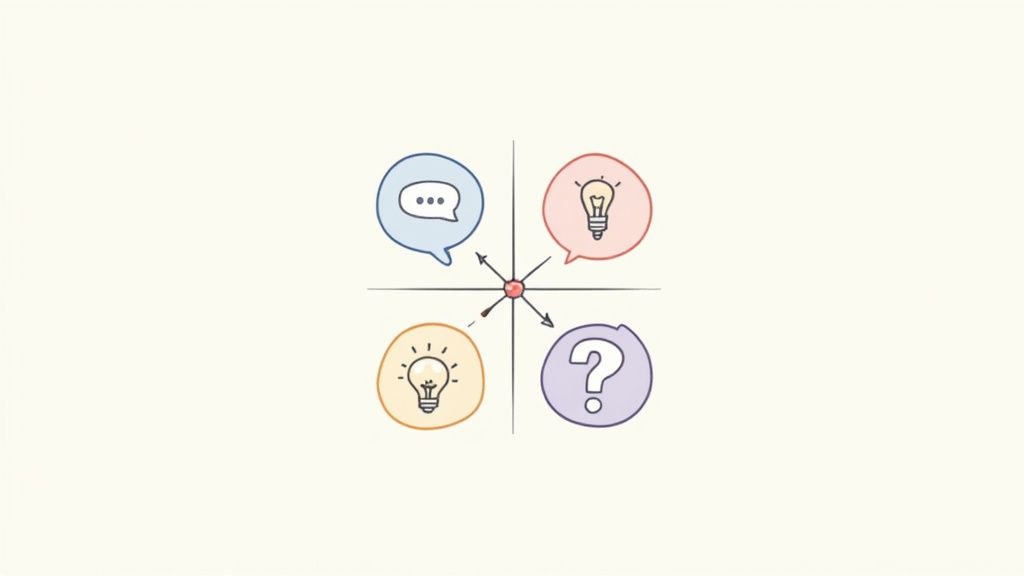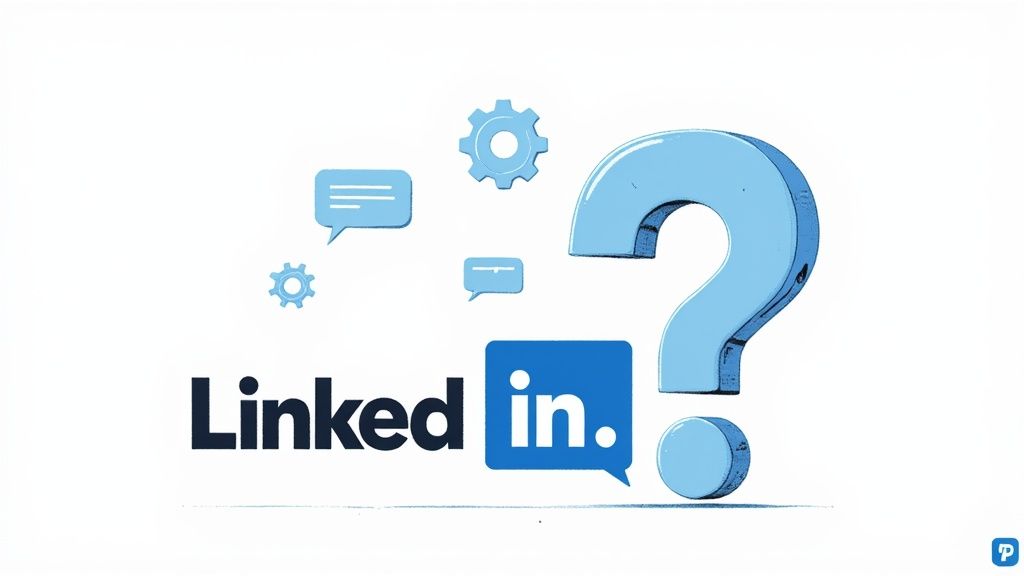Ethically Automate LinkedIn Posts on a Budget
Learn how to ethically automate LinkedIn posts to save time and grow your professional brand. Our guide covers affordable tools and sustainable strategies.

To really nail LinkedIn automation, you need a strategy that walks the fine line between consistency and authenticity. The best way I've found to do this is by using an ethical, affordable tool like Contentide that works with LinkedIn's official systems. It lets you schedule high-quality, pre-written content, saving you a ton of time while making sure you still sound like you.
The Smart Way to Automate Your LinkedIn Presence

We’ve all been there. Staring at that blinking cursor on LinkedIn's 'Create a post' screen, knowing we should be consistent to get any real traction. That pressure to show up every single day can easily lead to burnout or, even worse, just going silent.
This is exactly where a smart, ethical automation strategy can be a complete game-changer. It’s not just about saving a few minutes; it’s about building a reliable, affordable system that actually amplifies your professional brand.
When you get it right, automation makes sure your expert voice is heard consistently. You stay top-of-mind with your network, even when you're buried in other work.
Why Ethical Automation Matters
Look, an ethical approach is all about sharing value, not just blasting your connections with spam. It’s about setting up a system that frees you from the daily grind of content creation so you can focus on what really moves the needle: genuine conversations and real professional relationships.
Let the tech handle the logistics, so you can handle the human connection.
This isn't some fringe idea anymore. By 2025, LinkedIn automation tools have become a core part of professional networking, especially for businesses trying to scale their outreach without hiring a huge team. When you pair automation with smart personalization, these campaigns can actually get higher connection and response rates than doing it all by hand. It boosts your workflow and frees you up for more important, strategic tasks. You can dig into some of the industry benchmarks and their impact on sales and recruitment.
The whole point of automation should be to create more space for real human interaction, not to kill it. Use affordable, ethical tools for the repetitive stuff so you can pour that saved time back into commenting, messaging, and building actual connections.
The Benefits of a Smart System
For any busy professional looking for an effective and affordable solution, a well-planned automation system delivers some pretty clear wins.
- Keeps You Consistently Visible: Your profile stays active in your network's feed, reinforcing your expertise without you having to manually post every day.
- Gives You Your Time Back: It completely eliminates the 15-60 minutes many of us spend just trying to craft a single post.
- Maintains a Cohesive Brand Voice: When you plan your content in batches, you naturally create a more consistent tone and message across all your posts.
- Kills "Content Anxiety": Just knowing your content is scheduled and ready to go removes that daily stress of "what am I going to post today?"
Build Your Content Engine Before You Automate
Jumping straight into automation without a real content strategy is like building a house with no foundation. The fanciest, most expensive tools in the world can't save a weak message. Before you even touch a scheduler to automate LinkedIn posts, you need to build a content engine that churns out high-quality, valuable material consistently.
Don't overthink it. This engine doesn't need to be some complex, color-coded spreadsheet system. Seriously, all you need is a simple, affordable place to house your ideas—a Google Sheet or a Notion page works perfectly.
The whole point is to shift from stressful, last-minute brainstorming to a structured, repeatable process. And that process starts by defining your core content pillars.
Establish Your Core Content Pillars
Your content pillars are the 2-4 core themes you want to own. These are the topics where your expertise, experience, and genuine passion all connect. Just ask yourself: what problems do I solve for my audience, or what unique perspective can I bring to the table?
A marketing consultant I know, for instance, built their entire presence around these pillars:
- Ethical SEO Strategies: Sharing practical tips on sustainable, user-first optimization.
- Startup Growth Stories: Documenting raw, personal lessons from helping new businesses scale.
- Affordable Marketing Tech: Reviewing and recommending budget-friendly tools for lean teams.
These pillars act as your North Star for every piece of content. Every single post should tie back to one of them, reinforcing your authority and creating a narrative people can follow.
Ethically Repurpose Your Best Content
You absolutely do not need to invent something new from scratch every single day. One of the smartest and most ethical ways to fuel your content engine is by repurposing what you've already created. Take one killer piece of content—a blog post, a detailed case study, a project summary—and slice it up into a dozen smaller, bite-sized posts.
The secret to doing this well is adding a fresh angle or format each time. Never just copy and paste chunks of text. You have to reframe the core idea for a new context.
A single case study on a successful client project can easily be spun into a week's worth of unique posts. This is also where exploring how to use AI for content creation can really speed up the idea generation for all these different angles.
Here’s how that might look in practice:
- Post 1 (Personal Story): Kick things off by sharing the initial client challenge and how you felt about taking on the project.
- Post 2 (How-To Tip): Pull out one specific tactic you used and break it down so others can apply it themselves.
- Post 3 (Data/Statistic): Highlight a key metric, like a 45% increase in leads, and explain why that number actually matters.
- Post 4 (Question): Pose a question related to the project’s main theme to get a conversation started in the comments.
- Post 5 (Quote Graphic): Grab an impactful quote from the client’s testimonial and turn it into a simple, shareable image.
To help you visualize this, here's a simple matrix I use to map out ideas from a single pillar topic.
Content Pillar Idea Generation Matrix
This framework is a practical way to expand a single core topic into multiple LinkedIn post formats, ensuring your content schedule stays varied and engaging.
| Core Topic (Pillar) | Personal Story Post | How-To/Tip Post | Data/Statistic Post | Question/Poll Post |
|---|---|---|---|---|
| Ethical SEO | "The time I told a client to stop building links and what happened next." | "3 simple ways to improve your site's E-E-A-T without writing new content." | "Our client saw a 78% jump in organic traffic by focusing on this one overlooked metric." | "What's the most overrated SEO tactic right now?" |
| Startup Growth | "My biggest failure launching a new feature and the lesson it taught me." | "A step-by-step guide to validating your product idea for under $100." | "Startups that achieve product-market fit have this one thing in common (it's not funding)." | "What's one piece of advice you'd give to a first-time founder?" |
| Marketing Tech | "How I replaced a $500/mo tool with a simple, free automation." | "How to set up a basic marketing dashboard using free tools in under an hour." | "Fun fact: 60% of small businesses overspend on software. Here's why." | "What's one marketing tool you can't live without?" |
This approach ensures your automated schedule is always filled with non-repetitive content that provides genuine value from different perspectives. And remember, a great headline is half the battle; get fresh ideas from a free headline generator tool to make sure each repurposed post grabs attention.
So you’ve got your content engine humming. Now for the fun part: setting up a system to actually automate your LinkedIn posts so you can stay consistent without living on the platform.
The key here is picking a tool that respects your audience and, just as importantly, LinkedIn’s rules. We're talking about genuine value, not spammy outreach. I built Contentide for exactly this reason—an affordable, ethics-first tool designed for sustainable growth.
The whole point isn't just to schedule stuff. It's to build a workflow you can manage in minutes, not hours, each week. You don't need a massive budget or a ridiculously complex setup to see real results. It all starts with getting your accounts connected securely and your content organized.
Setting Up Your Automation Workflow
Getting started is refreshingly simple. I designed the process to be intuitive, moving you from connecting your account to organizing content and then scheduling in just a few logical steps.
This infographic breaks down the simple three-part workflow.

As you can see, effective automation boils down to a simple flow: a secure connection, well-organized content, and a schedule that feels natural.
First things first, you'll connect your LinkedIn account. Any ethical tool will use official LinkedIn APIs for this. That means your login info is never compromised. Think of it as a secure handshake between the platform and the tool—no shady back-door stuff that puts your account at risk.
Next, you'll pull in the content you’ve already prepped. Instead of having ideas scattered across Google Docs and random notes, you bring them all into one place. This creates a library of pre-approved posts, ready to go whenever you need them.
The real magic happens when you shift from manually posting every day to an organized, scheduled flow. This simple change can easily save you 15-60 minutes per day. That’s time you can now spend on actual engagement—the part of LinkedIn that truly builds relationships.
Creating a Natural and Varied Schedule
Just blasting out posts at random times isn't the goal. A smart, ethical automation strategy should mimic how a real person posts. That means creating a schedule that feels authentic and keeps your content mix fresh so your audience doesn't get bored.
This is where you can set some simple rules to maintain quality:
- Vary Your Content Pillars: Set up your schedule so you're not hammering the same topic two days in a row. Keep it interesting.
- Mix Up Post Formats: Make sure you’re alternating between personal stories, how-to tips, data-backed insights, and questions that spark conversation.
- Define Your Posting Times: Choose specific times of day that line up with when your audience is actually online and active.
You want a clean, simple interface to manage this. No guesswork.
A clear dashboard lets you manage your content library and your schedule with ease. This level of control ensures your automated feed never feels robotic or spammy. The best tools give you the power to "set it and forget it," but with the built-in intelligence to make sure your presence stays dynamic and valuable.
For anyone weighing different options, I put together a guide on how Contentide compares to other tools like Taplio. It offers a clear breakdown of features, with a focus on ethical and affordable automation.
Ultimately, this kind of system allows you to build a powerful, consistent presence on LinkedIn without ever sacrificing your authenticity.
Crafting a High-Performing Automated Content Mix

Alright, your automation system is plugged in and ready to go. Now comes the real work: the strategy. Simply firing off posts on a schedule won't cut it. To truly automate LinkedIn posts in a way that actually works, you need a smart, diverse content mix.
Let’s be honest, an endless stream of self-promotion is the fastest way to get your audience to tune out completely.
The goal here is to build a feed that feels authentic, varied, and genuinely valuable—even though it's automated. This means blending different post formats and themes to keep your network engaged and build real authority. Your automated schedule should never feel robotic; it should mimic the natural variety you'd see in a thoughtfully curated, manual feed.
Think of it like a good conversation at a networking event. You wouldn't just talk about yourself the whole time. You'd share stories, offer advice, ask questions, and listen. Your automated feed needs that same dynamic, ethical balance.
Balancing Value and Promotion
The absolute cornerstone of a high-performing content mix is the value-to-promotion ratio. A solid rule of thumb I've always followed is the 4-1-1 principle: for every one promotional post, you share one piece of relevant content from a third party and four pieces of your own original, value-driven content.
This ethical approach builds trust and positions you as a go-to resource, not just another salesperson clogging up the feed.
- Value-Driven Posts: These are your educational, insightful, or even entertaining pieces. Think "how-to" tips, personal stories from your career, industry analysis, or a peek behind the scenes.
- Promotional Posts: These have a clear call to action. You're asking someone to sign up for a webinar, download an ebook, or book a consultation.
When you follow this blend, your audience is far more receptive when you do ask for something, because you've consistently given them value first.
The Power of Rich Media in Automation
Varying your content format is just as important as varying the topic. This is where rich media becomes your secret weapon. The data doesn't lie: posts with images see double the engagement rates, and video content is shared a staggering 20 times more frequently.
This doesn't mean every single automated post needs an expensive, custom-produced video. It just means you need to program your automation schedule with a healthy mix of text-only updates, single images, carousels, and the occasional video.
Businesses that maintain a weekly posting cadence already see roughly twice the engagement. Weaving in rich media just amplifies that effect. Given LinkedIn's massive global reach, a visually diverse strategy is one of the easiest ways to stand out. For a deeper dive, check out the latest LinkedIn engagement statistics and user data.
An effective automated content mix is all about strategic variety. Never let your feed become a monotonous echo chamber. Schedule different formats on different days to keep your presence feeling fresh, human, and engaging.
By planning this variety ahead of time, your automation system can execute a sophisticated content strategy that builds your brand and drives real results—all without demanding your attention every single day.
Measure What Matters with Your Automation
Getting your system to automate LinkedIn posts is a massive win, but it’s only half the battle. If you're not tracking what's working, you're basically posting with your eyes closed. You need to look past the vanity metrics and focus on what actually moves the needle.
It's easy to get a cheap thrill from a sudden spike in impressions. We've all been there. But those numbers don't always tell the whole story. The real goal is to figure out what content truly connects with your audience, so you can stop guessing and start creating more of what they love.
This creates a powerful feedback loop: you post, you measure, you learn, and you refine. It’s how you turn a simple, affordable automation setup into a smart, data-driven engine for growth.
The KPIs That Actually Signal Growth
Forget trying to track every single number LinkedIn throws at you. That's a one-way ticket to analysis paralysis. Instead, just zoom in on the few key performance indicators (KPIs) that signal genuine audience connection.
- Engagement Rate: This is your North Star. It’s the raw measure of likes, comments, and shares relative to your views, and it tells you if people found your content compelling enough to actually do something.
- Inbound Profile Views: When a post truly hits the mark, people get curious. They want to know who’s behind the idea. A steady climb in profile views is a rock-solid sign that your content is attracting the right kind of attention.
- Quality of Comments: Don't just count comments; read them. Are people asking thoughtful questions or sharing their own experiences? Or are you just getting a lot of "great post!" drive-bys? The substance of the conversation is everything.
With the right automation, you should be aiming for connection acceptance rates between 30% to 50% and response rates north of 20%. By tracking these KPIs, you can see which messages are landing and which are falling flat, letting you tweak your approach in real-time.
The goal isn't just to be seen; it's to be remembered and respected. Focus on metrics that reflect genuine interest, not just passive views. This is the difference between building an audience and building a community.
Your Simple Monthly Review Framework
You don't need a complex dashboard. Just set aside 30 minutes once a month to look at the data. This simple habit is all you need to keep your content strategy sharp and effective.
During your review, ask yourself three simple questions:
- Which content pillar drove the most engagement? Find the theme that consistently sparked the best conversations.
- What post format performed the best? Was it that personal story, the how-to carousel, or a simple text post with some hard-hitting data?
- Which posts led to the most profile views? Pinpoint the exact content that made people curious enough to click on your name.
The answers are your roadmap for the next month. They'll tell you exactly what to double down on.
If you find that one type of content is a consistent winner, don't just post it again—remix it. Implementing effective content repurposing strategies is the secret to creating more of what works without burning yourself out. This is how your automation gets smarter and more effective over time.
Common Questions on LinkedIn Automation

When you start digging into LinkedIn automation, it’s only natural to have a few questions pop up. It's smart to be cautious—after all, your professional reputation is on the line. Let’s tackle the most common concerns I hear, looking at them through a lens of what’s ethical, affordable, and actually effective.
The biggest question is always about safety. Is it really safe to automate LinkedIn posts? The short answer is a confident yes, but it comes with one massive caveat: you have to use a tool that plays by LinkedIn’s rules.
That’s where ethical tools like Contentide come in. We use official LinkedIn APIs, which means we have a secure, approved connection to the platform. There’s no sketchy data scraping or weird behavior that could get your account flagged. As long as you stick with a reputable, ethical tool, your account is safe.
What Is the Ideal Posting Frequency?
Another one I get all the time is about the "magic number" for posting. How often should you be sharing content to see real, consistent growth? While there isn't a single answer that fits everyone, the secret isn't volume—it's consistency.
Based on what I’ve seen work for hundreds of professionals, posting three to five times per week is the sweet spot. This keeps you visible in your network's feed without spamming them. More importantly, it’s a sustainable pace that lets you focus on quality, not quantity.
Remember, the goal isn't to be the loudest voice in the room, but the most consistent and valuable one. An ethical automation strategy helps you maintain this rhythm without leading to burnout.
Your focus should be on creating a predictable cadence your audience can rely on. That’s how you build trust and get people looking forward to what you have to say.
What Are the Biggest Automation Mistakes to Avoid?
Finally, let's talk about the pitfalls. It's easy to make a few wrong turns when you're just starting out with automation. Knowing what to watch for can save you a ton of frustration and make sure your strategy actually delivers results.
Here are the most common ethical mistakes I've seen people make:
- Forgetting to Engage: Automation handles the posting, not the relationship-building. You absolutely still need to show up, reply to comments, and engage with others. This part is non-negotiable if you want to build a real community.
- Using a "Robotic" Voice: Your automated content must still sound like you. If your posts suddenly become generic or lose their personality, people will notice immediately. Always give any AI-generated content a final review and edit.
- Ignoring Analytics: Setting up automation and then walking away is a huge mistake. You need that feedback loop. The data tells you what’s resonating with your audience, so you can double down on what works and ditch what doesn't.
By sidestepping these common traps, you can make sure your automation efforts are a true asset to your professional brand, not a liability.
For more detailed answers, feel free to explore our full list of frequently asked questions about the platform and best practices. Moving forward with clarity is the key to making automation work for you.
Ready to build a consistent, authentic presence on LinkedIn without the daily grind? Contentide helps you generate high-performing posts in minutes. Start creating for free today.
Hope you found this helpful. Feel free to share your thoughts.